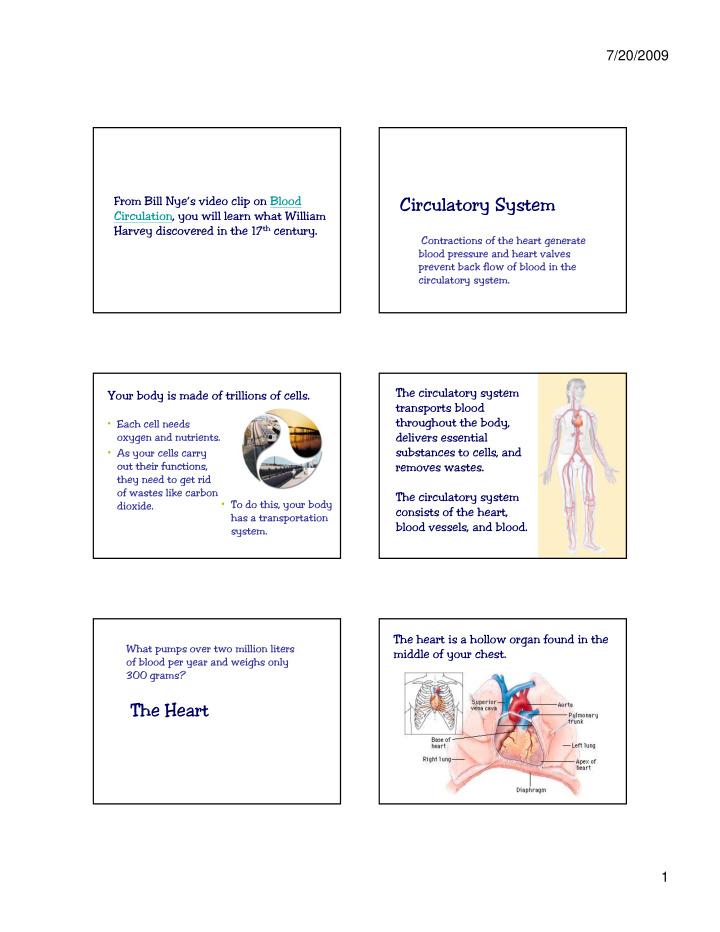



7/20/2009 From Bill Nye’s video clip on Blood Circulatory System Circulation, you will learn what William , y W Harvey discovered in the 17 th century. Contractions of the heart generate blood pressure and heart valves prevent back flow of blood in the circulatory system. The circulatory system Your body is made of trillions of cells. transports blood throughout the body, • Each cell needs oxygen and nutrients. delivers essential substances to cells, and • As your cells carry out their functions, out their functions removes wastes. removes wastes they need to get rid of wastes like carbon The circulatory system • To do this, your body dioxide. consists of the heart, has a transportation blood vessels, and blood. system. The heart is a hollow organ found in the What pumps over two million liters middle of your chest. of blood per year and weighs only 300 grams? The Heart The Heart 1
7/20/2009 The heart contracts to pump blood It is made mostly of cardiac muscle throughout the body. tissue . • Contractions happen when muscle tissue shortens. The right and left sides of the heart have separate functions. The right side of the heart collects oxygen-poor blood from the body and pumps it to the lungs where it picks up oxygen and releases carbon up oxygen and releases carbon dioxide. How the Heart Works The left side of the heart then collects oxygen-rich blood from the lungs and pumps it to the body so that every cell i cell in the body has the oxygen it the b d h the e it needs. 2
7/20/2009 The heart has four chambers. The heart contracts (or beats) in two Each chamber has a one-way valve at stages. its exit. • Blood enters the atria • A valve is a flap of tissue that prevents the first. backflow of blood. • The left atrium receives • When each chamber contracts, the valve at , oxygen-rich blood from its exit opens. the lungs. • When a chamber relaxes, the valve closes • The right atrium so that blood does not flow backwards. receives oxygen-poor blood from the body. When the atria contract, blood is In the second stage, while the atria relax, squeezed into the ventricles. the ventricles contract together. • This pushes blood out of the heart. • Blood from the right Blood from the right ventricle goes to the lungs. • Blood from the left ventricle goes to the rest of the body. 3
7/20/2009 1. Oxygen-poor blood (shown in blue) flows from Then the heart muscle relaxes before the body into the right atrium. the next heartbeat. 2. Blood flows through the right atrium into the right ventricle. • This allows blood 3. The right ventricle pumps the to flow into the blood to the lungs, where the blood releases atria again. g waste gases and picks up oxygen waste gases and picks up oxygen. 4. The newly oxygen-rich blood (shown in red) returns to the heart and enters the left atrium. 5. Blood flows through the left atrium into the left ventricle. 6. The left ventricle pumps the oxygen-rich blood to all parts of the body. Click to see a review from Encarta on Blood Circulation. 4
Recommend
More recommend